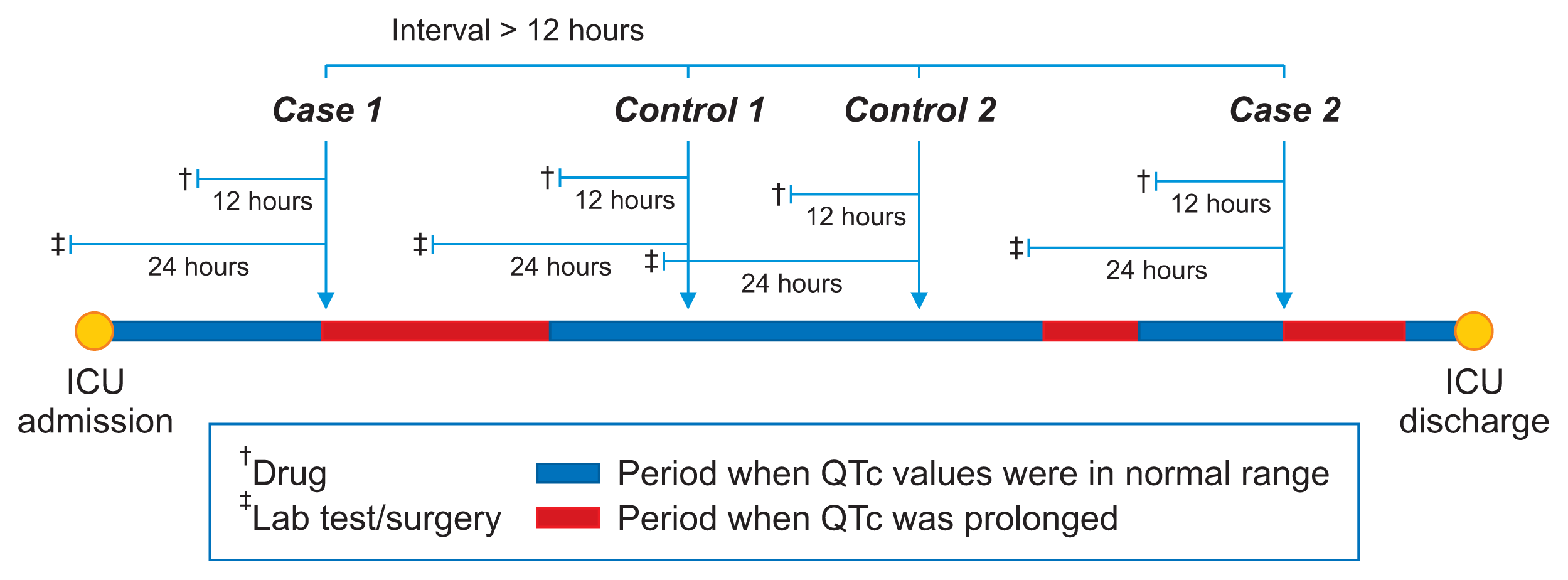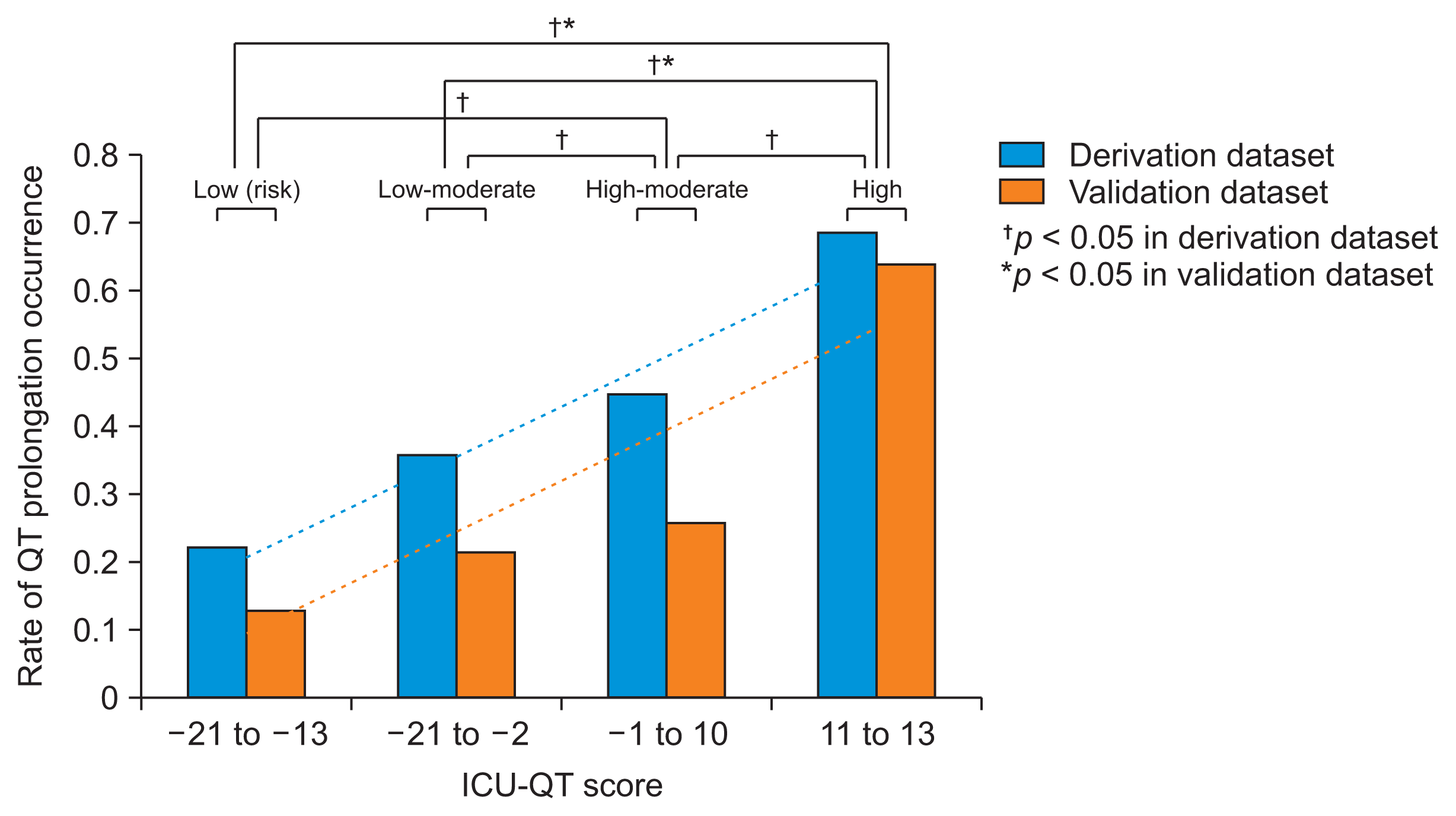1. Pickham D, Helfenbein E, Shinn JA, Chan G, Funk M, Weinacker A, et al. High prevalence of corrected QT interval prolongation in acutely ill patients is associated with mortality: results of the QT in Practice (QTIP) Study. Crit Care Med. 2012; 40:394–9.
2. Etchegoyen CV, Keller GA, Mrad S, Cheng S, Di Girolamo G. Drug-induced QT interval prolongation in the intensive care unit. Curr Clin Pharmacol. 2017; 12:210–22.

3. Beitland S, Platou ES, Sunde K. Drug-induced long QT syndrome and fatal arrhythmias in the intensive care unit. Acta Anaesthesiol Scand. 2014; 58:266–72.

4. George TK, Chase D, Peter JV, Satyendra S, Kavitha R, George LR, et al. Association between a prolonged corrected QT interval and outcomes in patients in a medical Intensive Care Unit. Indian J Crit Care Med. 2015; 19:326–32.

5. Fernandes FM, Silva EP, Martins RR, Oliveira AG. QTc interval prolongation in critically ill patients: prevalence, risk factors and associated medications. PLoS One. 2018; 13:e0199028.

6. Tisdale JE, Wroblewski HA, Overholser BR, Kingery JR, Trujillo TN, Kovacs RJ. Prevalence of QT interval prolongation in patients admitted to cardiac care units and frequency of subsequent administration of QT interval-prolonging drugs: a prospective, observational study in a large urban academic medical center in the US. Drug Saf. 2012; 35:459–70.
7. Kozik TM, Wung SF. Acquired long QT syndrome: frequency, onset, and risk factors in intensive care patients. Crit Care Nurse. 2012; 32:32–41.

8. Hoogstraaten E, Rijkenberg S, van der Voort PH. Corrected QT-interval prolongation and variability in intensive care patients. J Crit Care. 2014; 29:835–9.

9. Nagele P, Pal S, Brown F, Blood J, Miller JP, Johnston J. Postoperative QT interval prolongation in patients undergoing noncardiac surgery under general anesthesia. Anesthesiology. 2012; 117:321–8.

10. Pham JC, Banks MC, Narotsky DL, Dorman T, Winters BD. The prevalence of long QT interval in post-operative intensive care unit patients. J Clin Monit Comput. 2016; 30:437–43.

11. Vandael E, Vandenberk B, Vandenberghe J, Spriet I, Willems R, Foulon V. Development of a risk score for QTc-prolongation: the RISQ-PATH study. Int J Clin Pharm. 2017; 39:424–32.

12. Bindraban AN, Rolvink J, Berger FA, van den Bemt PM, Kuijper AF, van der Hoeven RT, et al. Development of a risk model for predicting QTc interval prolongation in patients using QTc-prolonging drugs. Int J Clin Pharm. 2018; 40:1372–9.

13. Berger FA, van der Sijs H, Becker ML, van Gelder T, van den Bemt PM. Development and validation of a tool to assess the risk of QT drug-drug interactions in clinical practice. BMC Med Inform Decis Mak. 2020; 20:171.

14. Su K, McGloin R, Gellatly RM. Predictive validity of a QTc interval prolongation risk score in the intensive care unit. Pharmacotherapy. 2020; 40:492–9.
15. Chung D, Choi J, Jang JH, Kim TY, Byun J, Park H, et al. Construction of an electrocardiogram database including 12 lead waveforms. Healthc Inform Res. 2018; 24:242–6.

16. Chesnokov YC, Nerukh D, Glen RC. Individually adaptable automatic QT detector. In : Proceedings of 2006 Computers in Cardiology; 2016 Sep 17–20; Valencia, Spain. p. 337–40.
17. Mehta HB, Mehta V, Girman CJ, Adhikari D, Johnson ML. Regression coefficient-based scoring system should be used to assign weights to the risk index. J Clin Epidemiol. 2016; 79:22–8.

18. Yoon D, Lee S, Kim TY, Ko J, Chung WY, Park RW. System for collecting biosignal data from multiple patient monitoring systems. Healthc Inform Res. 2017; 23:333–7.

19. Sharma S, Martijn Bos J, Tarrell RF, Simon GJ, Morlan BW, Ackerman MJ, et al. Providers’ response to clinical decision support for QT prolonging drugs. J Med Syst. 2017; 41:161.

20. Tisdale JE, Jaynes HA, Kingery JR, Overholser BR, Mourad NA, Trujillo TN, et al. Effectiveness of a clinical decision support system for reducing the risk of QT interval prolongation in hospitalized patients. Circ Cardiovasc Qual Outcomes. 2014; 7:381–90.

21. Woosley RL, Heise CW, Gallo T, Tate J, Woosley D, Romero KA. QTdrugs list [Internet]. Oro Valley (AZ): AZCERT Inc;c2013. [cited 2021 Mar 30]. Available from:
https://www.crediblemeds.org/
.
22. Kim NY, Han DW, Koh JC, Rha KH, Hong JH, Park JM, et al. Effect of dexmedetomidine on heart rate-corrected QT and Tpeak-Tend intervals during robot-assisted laparoscopic prostatectomy with steep Trendelenburg position: a prospective, randomized, double-blinded, controlled study. Medicine (Baltimore). 2016; 95:e3645.
23. Agdanli D, Ozturk T, Utuk O, Keles GT. Effects of high-dose rocuronium on the QTc interval during anaesthesia induction in patients undergoing coronary artery bypass graft surgery. Turk J Anaesthesiol Reanim. 2014; 42:245–50.





 PDF
PDF Citation
Citation Print
Print





 XML Download
XML Download